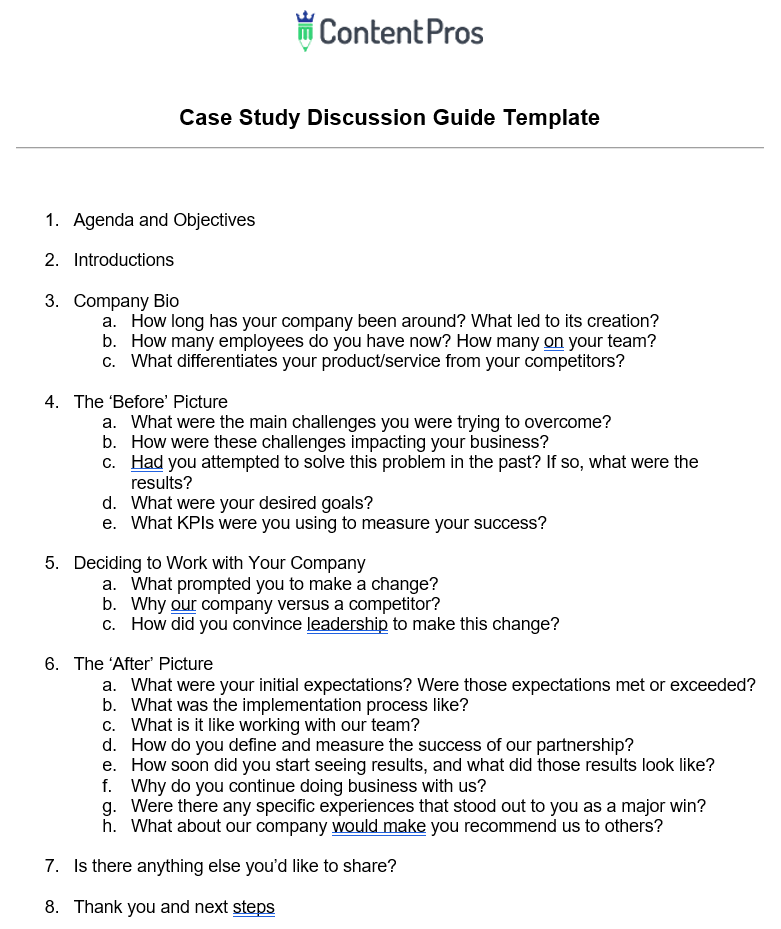Mastering the art of writing a case study can help you skyrocket your sales. Research shows that case studies are the most effective tool in accelerating and converting leads. People don’t like to be sold to, but they don’t seem to mind a good story that can help them make a buying decision.
Case studies build brand authority and social proof by illustrating how your product or service solves real business problems. To reap these benefits, you’ll need to know what to include in a case study and how to go about collecting the right data from the right people.
How exactly can you put case study marketing to work in your business? Leverage these best practices to squeeze the most value from your case study strategy.
What Is a Case Study?
A case study is essentially a story. It gives a detailed look at how a customer is using your product or service. In a case study, you’ll discuss:
- Who the client is
- The business problem they want to solve
- Other solutions they tried or considered
- How they chose your product or service
- What they like about your product or service
- The results they achieved
Ideally, prospective customers reading your case studies can learn from others’ experiences—and hopefully purchase from you.
73% of the most successful B2B content marketers use case studies – Content Marketing Institute
Case study marketing is one of the most classic and time-tested examples of content marketing. Even before the term “content marketing” was coined and became one of the biggest priorities for marketers, case studies were the secret weapon in the marketing toolbox. Today, their benefits have only grown, and more marketers are taking notice.
How to Write a Case Study
People, data quality, and structure all play a part in case study writing. Follow these steps to create effective case studies for your organization.
1. Develop Your Internal Approach
Your approach to case studies can have a lot to do with the outcome. Before you reach out to potential subjects, it’s a good idea to systematize internal processes to create the final product you envision.
Here are some ideas to get the creative juices flowing:
- Define a clear purpose for your case studies (e.g., highlight a specific product or service, showcase a high-profile client).
- Connect with your sales and customer service teams to learn about common questions or rejections your case studies could address.
- Identify your best-selling features that retain customers. In other words, figure out what value you deliver to your customers and what makes them choose you.
- Select a team member to conduct the case studies, ideally someone with great interviewing skills and the ability to think on their feet.
- Create a marketing case study discussion guide to get the most out of each interview and avoid reinventing the wheel with each one.
- Determine how many case studies you plan to write each year and integrate them into your content calendar.
Share this information with your marketing team and develop a process for identifying target customers and gaining their agreement to do the case study.
2. Identify the Ideal Customer for Your Case Studies
Every case study is built around a specific customer’s experience in working with you to solve a business problem. For marketing purposes, each of your case study subjects needs to meet two criteria: they have positive, measurable results AND they represent your target market(s).
Case studies go beyond the basic customer testimonial. In a case study, you dive deeper into the business problems your customers were trying to solve when they came to you. Ideally, your customers should provide stats and KPIs that illustrate how you’ve helped them improve.
When you choose a customer that represents the people you’re trying to attract, your content will have a better chance of resonating with them. They can relate to a company that has experienced similar problems, is in the same industry, or serves a similar clientele.
Keep in mind that not all customers will be good candidates for a case study. It’s important to get specific about your target audience and goals, then choose customers that can best represent them.
3. Create a Discussion Guide That Builds Trust with Your Readers
Effective case study interviews are carefully directed with questions designed to influence the reader. The information you collect will be woven into a story—a story that is about you just as much as it is about your customer.
It’s not enough to throw in numbers and expect them to wow your audience. You need to be able to back up your claims with proof, and using data is one of the best ways to build trust with your audience. In case studies, data comes straight from the source and provides context into how that data was collected and what it means.
As you write your case study interview discussion guide, think about questions whose answers will build trust with your readers. Keep the reader in mind and what they should take away from the case study. This will help you decide the most important questions to ask.

4. Conduct a Compelling Interview
Interviewing your case study client isn’t just about going through your question list. The questions should serve as a guide, but you should allow room (and time) to dig deeper into their responses.
One-on-one interviews give you a chance for immediate feedback and follow-up questions. This means going off-script when necessary to get the richest details. Their responses can open the door to new insights and questions you didn’t think to ask before. These will be unique to each client; otherwise, all of your case studies risk sounding the same.
Throughout the interview, focus on creating a before-and-after snapshot that takes readers through the entire story, not just the end result. Developing a bio on the company and focusing on the initial problems can add clarity to your data and illustrate the company’s progress while using your product or service.
Bonus Tip: Record the interview so you can go back and pull direct quotes and other important details that may be glossed over during the live interview.
5. Write Your Case Study in an Organized Manner
Case studies come in many shapes and sizes: some are entire blog-length articles, while others are graphic one-sheeters. There’s no right or wrong way here, but it’s helpful to choose a consistent format to make writing the case study easier.
Here’s an outline you can adapt to create a repeatable case study format:
- A compelling title that includes the client’s name and ideally a data point (e.g., Case Study: How Client XYZ Increased Page Views By 500% with Content Pros)
- A brief introduction to the client and the problem
- A “before” snapshot detailing what the client was doing before your solution
- A section on how the client chose you as the solution
- An “after” snapshot highlighting specific results they achieved with your product or service
- At least one quote from someone directly involved in solving the problem (bonus points if you can get their headshot)
- Visual elements to illustrate the data, if possible
Finally, you should have an idea of what the ideal outcome will look like: Should the reader schedule a call or demo? Make a purchase? Upgrade their service? Don’t leave the end result to chance—include a call to action for readers to move them to the next step.
Once you have a case study format, you can turn it into a template to reuse for future case studies.
6. Create a Win/Win Experience
When executed correctly, case studies should offer value to you and your customers. The less one-sided your request, the more likely they may be to participate.
Work with your client to ensure they can benefit from sharing their time and information with you. For example, you might include a backlink in the case study that can help their SEO strategy. They’ll also receive publicity every time someone reads your content.
You might even help them promote the case study on their own channels to give you both more exposure.
Marketing Case Study Example
With these tips in mind, let’s see how they come together to create powerful sales tools.

Content Pros client datapine offered to be part of a case study. Being in the business of Big Data, it was easy for them to demonstrate tangible results using our professional writing services. This case study includes:
- A strong, descriptive title: How datapine Doubles Organic Traffic Every Year
- Information about the client’s business
- The problem we solve for them (in this case study, the client aims to turn complex topics into bite-sized, easy-to-understand content)
- Details on their implementation and customer service experience
- Real-life data points on how we helped solve their problem and the results they achieved (with visuals)
- Our custom approach to working with the client
This case study is more in-depth than an average blog post. It’s data-rich, includes lots of visuals, and has a clear call to action at the end.
However, not all case studies have to be this in-depth, depending on your goals. We could turn this case study into a sales one-sheeter, highlighting the most salient points without going into great detail. This is one way to repurpose your content for different audiences and goals.
Hire a Professional Content Writer to Turn Data into Goal-Focused Opportunities
Writing an effective case study takes a unique skill set that other types of content (e.g., blogs, infographics, social media posts) don’t usually require. A professional content writer who has experience turning facts and data into stories that sell can maximize the impact of your case study. You’ll have a better chance of bringing your client’s voice to life and resonating with your target market.
After you publish your case study, don’t stop there. Maximize its value by transforming it into blog posts, infographics, and lead magnets and share them via email and social media. Professional case study writers can help you do all of the above efficiently and effectively. To see how we work and meet your dedicated writing team, start your commitment-free discounted trial today.


